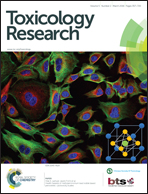Testicular and epididymal toxicity induced by benzo(a)pyrene, alcohol, and their combination in Wistar rats†
Abstract
Alcoholism and cigarette smoking are pervasive problems that have been implicated in human health. In this study, independent and combinative toxicities of alcohol and benzo(a)pyrene (BaP) were tested for reproductive toxicity in rats. Male Wistar rats were exposed to BaP (100 μg per kg body weight) on alternative days and alcohol (2 g per kg body weight per day) daily, either individually or in combination for 60 days. Exposure to BaP or alcohol significantly decreased the fertility index and reduced the number of implantations associated with elevated pre- and post-implantation losses. The relative weights of testes, epididymis, seminal vesicles, and prostate gland were significantly decreased in BaP or alcohol administered rats. Exposure to BaP or alcohol significantly decreased daily sperm production, sperm density, percentages of motile, viable, HOS-tail swelled sperm, testicular 3β- and 17β-hydroxysteroid dehydrogenase activity levels, mRNA levels of steroidogenic acute regulatory protein, and serum testosterone levels. Further, in silico studies revealed the binding of BaP at the hydrophobic tunnel of StAR protein. Additional studies disclosed stable interactions of BaP with the amide group of ASN150 and the hydroxyl group of THR263 by forming three hydrogen bonds. Our results also showed that treatment of rats with BaP or alcohol caused a marked increase in levels of superoxide anions, hydrogen peroxide, and lipid peroxidation in testis and epididymis. Conversely, glutathione levels and activity levels of superoxide dismutase, catalase, glutathione peroxidase, and glutathione reductase in testis as well as epididymis decreased significantly in the experimental rats. Under the same conditions, increased fragmented DNA levels were observed in sperm. The results of the present study indicate that exposure to BaP or alcohol adversely affected the male reproductive functions, which may be, at least in part, due to androgen deficiency and/or oxidative stress-related mechanisms. Consistently, the present results also showed higher reproductive toxicity upon exposure to combinations of BaP and alcohol than upon their individual treatments. Therefore, this combination was classified as additive and synergistic responses of BaP and alcohol.



 Please wait while we load your content...
Please wait while we load your content...